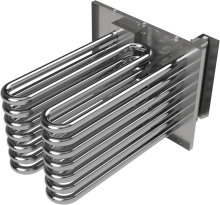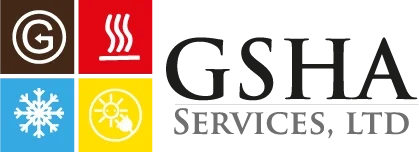We Give Free Second Opinion On Cracked Heat Exchanger
We give free second opinions on cracked heat exchanger. In a typical season, our technicians confirm more than 60% of red tags related to cracked heat exchangers are erroneous. If another company says the heat exchanger in your furnace is cracked, rusted, or broken in any way, We will come to your house at no charge to confirm the diagnosis. In many cases our technicians find that the other company’s diagnosis is wrong and the heat exchanger is perfectly fine. Sometimes we do find that the previous diagnosis was correct, and a new heat exchanger is needed before the furnace can operate safely. Either way, our second opinion service will give you the peace of mind that your family is safe.
What Is a Heat Exchanger?
A heat exchanger is a furnace part that transfers the heat generated by gas combustion to air. In most simple terms, this is the very part that heats the air. Gas furnaces can use several types of heat exchangers like shell and tube heat exchanger, plate and shell heat exchanger, and finned tube heat exchanger. They all have the same working principle. In most cases, the heat exchanger is basically a set of tubes with repeated loops. All these tubes are made out of metal like copper and nickel.

We’re A Repair-First Company
GSHA Services, LTD is a repair-first company. This means we are motivated to fix, not replace, for the lowest cost. We are not a commission-based company. We only recommend a full system replacement as a last resort. We’ll even encourage you to get a second opinion. We’re confident you won’t find a better deal.
What Are The Dangers Of A Cracked Heat Exchanger?
A crack in the heat exchanger can allow poisonous carbon monoxide (CO) to leak into your home, leading to illness or even death. Additionally, because your heat exchanger is such an integral part of your heating system, it’s typically an expensive problem. Therefore, any cracks found in your heat exchanger should be addressed promptly in order to maintain safety and comfort.
Carbon Monoxide Leaks
Gas furnaces naturally emit carbon monoxide (CO), nitrous oxide, and sulfur dioxide as byproducts of combustion. Your furnace utilizes built-in vents to usher these toxic gases outdoors and safely away from your home. However, if there is a crack in your heat exchanger, those gases can leak and be released into your home.
Carbon monoxide is particularly dangerous because it is tasteless, colorless and odorless, and breathing it can lead to sickness and even death. While all homes should have CO detectors, these devices do not stop the spread of this deadly gas; like a smoke detector, it only warns you of the gas’s presence.
Furnace Fires
When a mixture of gas and air combust in the heat exchanger, uncombusted gas builds up until it reaches a high enough volume to be explosive. When it becomes explosive, it combusts and forces flames and air pressure out of any accessible hole, such as a cracked heat exchanger.
Furnace fires are not only threatening to your safety, but also extremely expensive to recover from. You may have to repair damage to your home or replace cherished possessions. Don’t take the risk! Be sure to schedule an annual maintenance check on your furnace.
Decreased Air Quality
A cracked heat exchanger allows other harmful gases, like sulfur dioxide and nitrogen oxides, to escape into your home. These gases can irritate the lungs and cause respiratory issues, particularly for those with asthma or other pre-existing conditions.
Furnace Failure
Over time, a cracked heat exchanger can cause extensive damage to the furnace itself. This can result in the need for expensive repairs or even a complete system replacement, especially if the crack goes undetected for a long period.
Reduced Energy Efficiency
A cracked heat exchanger can prevent the furnace from operating at peak efficiency. It may struggle to heat your home properly, leading to higher energy bills as the system works harder to maintain the desired temperature.
Void Manufacturer’s Warranty
If your furnace is under warranty, ignoring or delaying repairs to a cracked heat exchanger can void the warranty, leaving you responsible for the full cost of repairs or replacement.
If you suspect a cracked heat exchanger, it’s important to shut off the furnace and call a certified HVAC technician immediately for an inspection and repair to avoid these risks.
Signs Your Furnace Heat Exchanger May Be Cracked
- Soot Or Black Carbon Build-Up – Soot build-up in or around the burners of your furnace.
- Furnace Smells Like Formaldehyde – A malfunctioning heat exchanger will often create an unpleasant and strong odor that smells similar to formaldehyde.
- Corrosion – Corrosion is a chemical reaction between a metal and, in most cases, water. Corrosion is basically a sign of prolonged moisture and can be one of the symptoms of a failed secondary heat exchanger. If you see corrosion, this may be a subtle sign of a cracked secondary heat exchanger.
- Cracked Furnace – The simplest way to visibly detect a heat exchanger crack is to check the entire framework of the furnace. If your furnace is cracked on the outside, chances are the internal parts are not intact as well. This also includes issues with the heat exchanger.
- Change in the Flame Appearance – In most furnaces, you can see the flame that heats your air. Remember: blue is normal, orange or yellow is not.
- Audible Sounds – If you have a crack in the heat exchanger, you are likely to hear a rattling noise as your thermostat turns on the heat. Because the heat exchanger is made out of metal, as it is heated cracks will expand/contract, and can cause rattling, popping, and/or banging noises.
- Presence of Carbon Monoxide – Carbon monoxide (CO) is an odorless, colorless, and tasteless flammable gas which is toxic. A failed heat exchanger may leak CO into your home. Only a carbon monoxide detector or alarm will alert you of the presence of CO, however, do not completely rely on a CO alarm to discover a failed heat exchanger – we recommend yearly inspection of your furnace and heating system.
How To Know Your Heat Exchanger Needs To Be Replacement?
Heat exchangers need to be replaced if their metal coils are visibly cracked. If a tech comes to your home and says you need to replace your heat exchanger, ask them to physically point out the crack. According to the Air-Conditioning, Heating and Refrigeration Institute (AHRI), “Any crack or hole that is big enough to affect combustion will be easily visible to the naked eye.” That means the technician should point out to you exactly where the crack is so you can see the heat exchanger needs to be replaced. Unfortunately, some dishonest technicians use deceiving methods like smoke testing to “prove” you have a cracked heat exchanger. However, these methods are not accurate, and are often used to scare homeowners into buying a new furnace when they don’t really need one.
What Causes Cracked Heat Exchangers
Simply explained, a heat exchanger cycles through being heated and cooled. This intended cycle makes the component’s metal constantly expand and contract. Over time this wears out the heat exchanger. Eventually, the metal will crack as a result of stress and fatigue. Even if your furnace is in good condition, cracks are inevitable after years of normal wear and tear.
If you maintain your furnace well through its life, you can prevent those cracks from appearing for a considerable amount of time. Cracks in the heat exchanger can develop much faster if your furnace is poorly maintained or improperly installed.
Free Second Opinion In Chicago, IL And Surrounding Areas
GSHA Services, LTD offers free second opinions on cracked heat exchanger for Chicago, IL and surrounding area. Give us a chance to provide you with a competitive quote and a second pair of eyes on your heating system. Contact us today at (224) 258-0510 to schedule service! We are available 24 hours a day, 7 days a week. Please contact us and we will be glad to help.
